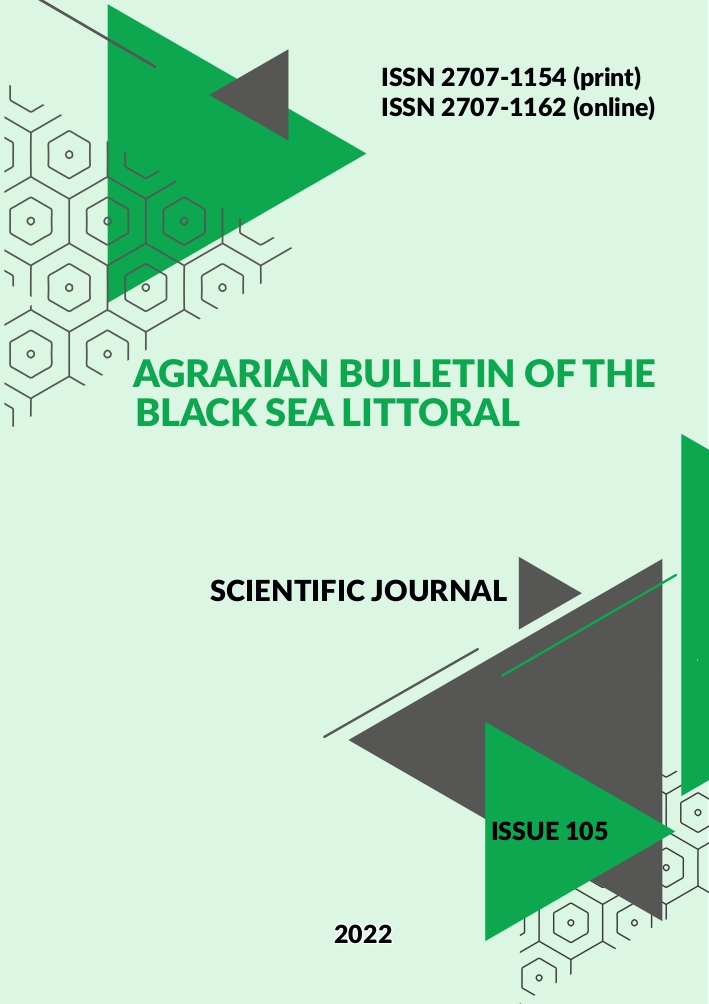THE DYNAMICS OF SOME FACTORS OF NON-SPECIFIC RESISTANCE OF SOWS DEPENDING ON THE PERIOD OF COMPOUNDING
DOI:
https://doi.org/10.37000/abbsl.2022.105.06Keywords:
sow, non-specific resistance, BASK, LASK, FAN, FchAbstract
The indicators of nonspecific resistance of gestating sows were studied. The research was conducted on analog sows. In the blood obtained from the anterior vena cava, the leukocyte formula was counted, the phagocytic activity of neutrophils, including the phagocytic number, was determined, and the bactericidal and lysozyme activity of blood serum was determined.
Studies have shown that in the first half of farrowing, the highest values of bactericidal activity of blood serum were in the groups of young sows. In the second half of farrowing, a decrease in bactericidal activity of blood serum was observed in sows of the first two farrowings (p<0.01; p<0.05). In sows of the third farrowing, the decrease in this indicator is slightly expressed.
In the first half of farrowing, serum lysozyme activity is higher in sows of the first and second farrowing in 1.40 - 1.1.29 times (p<0.01; p<0.05), the lowest - in sows of the third farrowing. At the end of farrowing this index increases in all sows, but in animals of 1-2 farrowing this increase is more significant than in sows of the third farrowing.
The highest phagocytic activity of neutrophils was noted in sows of the second farrowing, by the end of farrowing they have a significant decrease (p<0.05) of this indicator.
The absorption capacity of neutrophils also significantly decreases at the end of farrowing (p<0.01) compared to the beginning of the study. In sows of the third farrowing it was lower than in animals of the first and second farrowing by 1.37 times (p<0.01).
Thus, sows of the first and second farrowing are characterized by higher rates of bactericidal activity of blood serum in the first half of farrowing. At the end of the study, this indicator significantly decreased before farrowing. Moreover, the level of this indicator during this period was lower than in sows of the third farrowing.
In addition, sows of the first two pregnancies are characterized by high levels of lysozyme activity, as well as a decrease in the phagocytic activity of neutrophils in the first half of pregnancy.
As a result of the studies, periods of unstable state of nonspecific protection of the organism were determined. This will allow not only to detect the impact on the body in order to restore the already impaired resistance, but also to prevent these disorders in the established disadvantaged groups of animals, more differentially select means that strengthen the body's resistance.
Studies are planned to find out the resistance of piglets and study the effect of drugs on the immune status of sows and newborn piglets.
References
Glynn, A.A. Lysozyme and immune bacteriolysis Текст. / А.А. Glynn, C.M. Milne //Nature. 1965. -V. 207. - P. 1309-1310.
А. Ф. Современное состояние учения о фагоцитозе: Обзор. Иммунология. 1983. №1. С.20–21
Баркарь Є. В. Залежність біохімічних параметрів сироватки крові свиней великої білої породи та рівня живої маси у ранньому постнатальному онтогенезі. Таврійський науковий вісник. Херсон. 2006. Вип. 44. С. 115–119.
Баско С. О. Резистентність і продуктивність свиней за дії абіотичних і біотичних факторів : автореферат дисертації … кандидата вет. наук : 16.00.06. Харків, 2016. – 22 с.
Березовський М. Д., Ващенко П. А., Троїцький М. Я. Гематологічні показники свиней великої білої породи вітчизняної і зарубіжної селекції. Вісник Полтавської державної агарної академії. 2006. №4. С. 171–173.
Большакова Н. В. Резистентность и реакция на стресс-факторы чистопородных и помесных свиней: Автореф. дисс. канд. с.-х. наук. Троицк, 1998. 18с.
Войтенко С., Пономаренко В. Прогнозування продуктивності свиней за біохімічними показниками крові. Тваринництво України. 2011. №8. С. 11–13.
Галочкин В., Остренко К., Галочкина В., Федорова Л. Взаимосвязь нервной, иммунной, эндокринной систем и факторов питания в регуляции резистентности и продуктивности животных. Сельскохозяйственная биология. 2018. Том 53. № 4. С. 673–686.
Галочкин В. А., Черепанов Г. Г. Неспецифическая резистентность продуктивных животных: трудности идентификации, проблемы, пути решения. Проблемы биологии продуктивных животных. 2013. №1. С. 5–29.
Голубець О. В. Природна резистентність свиноматок при дефіциті мікроелементів. Вісник Білоцерківського Державного аграрного університету. 2000. Вип. 13. ч. 2. С. 58–62.
Дорофейчук В. Г. Определение лизоцимной активности сыворотки крови нефелометрическим методом. Лабораторное дело. 1968. № 1. С. 28–31.
Кардач И. И. Влияние паратипических факторов на естественную резистентность и продуктивность свиней. Вісник аграрної науки Причорномор’я. 2013. Вип. 4 (75). Т. 2. ч. 1. С. 104–110.
Маслянко Р. П. Пукало Л. Я. Показники неспецифічної резистентності свиноматок за корекції залізодефіцитних раціонів. Науковий вісник Львівського національного університету ветеринарної медицини та біотехнологій імені С. З. Ґжицького. 2007. Т.9, №3. ч. 3.С. 126–129.
Чумаченко В.Е. Методические рекомендации по определению естественной резистентности у сельскохозяйственных животных для ветеринарных специалистов /В.Е. Чумаченко. – К., 1992. – 86 с.
Івченко В.М. Методи імунологічних досліджень в лабораторіях ветеринарної медицини: метод. Рекомендації для лікарів-імунологів лабораторій вет. медицини /В.М. Івченко, Н.І. Сахнюк. – Біла Церква, 2009. – 81с.
Карпуть И.М. Иммунология и иммунопатология болезней молодняка / И.М. Карпуть.– Минск: Ураджай, 1993. – 288 с.


